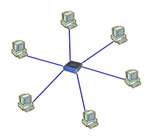Network Topologies
Topologies are of two types namely ;physical and logical. Physical refers to physical layout of the computers, printer, and other devices on the network . A logical topology on the other hand; determines how the hosts communicate across a medium, such as cable or the airway.
The type of topology determines the capabilities of the network, such as ease of setup, speed, and cable lengths.
Physical Topologies:
- Bus
- Ring
- Star
- Hierarchical or External Star
- Mesh
Bus Topology: each computer is connected to a common cable. The cable has a small cap installed at the end, called a terminator. The terminator prevents signals signals from bouncing back and causing network error.
Ring Topology : Hosts are connected in a physical ring or circle. Because the ring topology has no end, the cable does not need to be terminated. A token travels around the ring, stopping at each host.
Star Topology: The star topology has a central connection point, which is normally a device such as a hub, switch, or router. The advantage of a star topology is that it is easy to troubleshoot. Each host is connected to the central device with its own wire. If there is a problem with that cable, olny that host is affected.

Hierarchical or Extended Star Topology: is a star network with an additional networking device connected to the main networking device. A`network cable connects to one hub, and then serveral other hubs connects to the first hub. Universities and large companies use the hierarchical star topology.
Mesh Topology: this topology connects all devices to each other- this makes it hard for the network to be affected by a failure in a cable. This network is used in WAN- Wide Area Network.
Logical Topolgies:
Types of logical topologies:
- Broadcast- each host addresses either data to a particular host or to all hosts connected on a network. The advantage; there is no order that the host must follow to use the network .
- Token Passing- controls network access by passing a electronic token sequentially to each host. When a host receives the token, it can send data on the network. if the host has nodata to send, it passes the token to the next host.




November 8, 2009 at 9:51 pm
I only knew of the three basic type of network topology; which are- Ring, Bus, and Star . its interesting however to learn of new ones for examples:
Hierarchical or Extended Star Topology
Mesh Topology.
December 14, 2009 at 2:29 pm
The video chip is simple and easy to understand